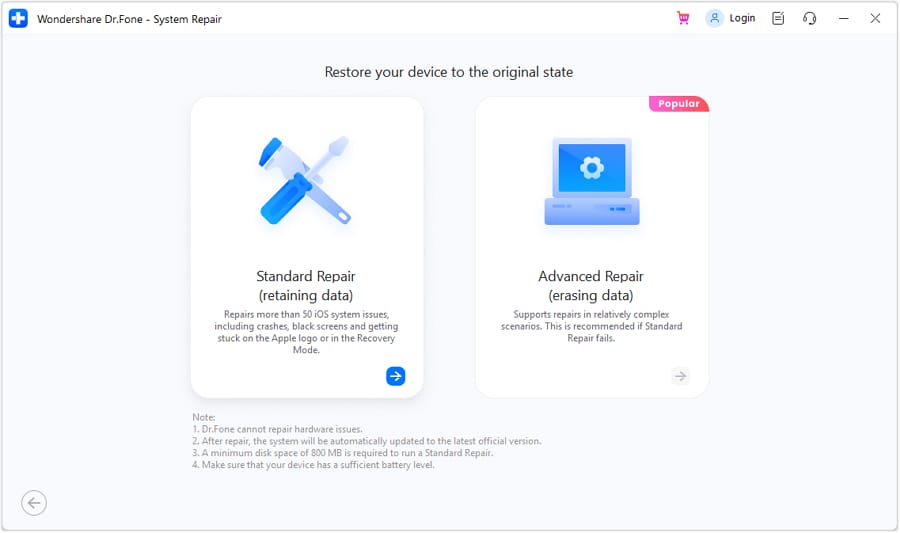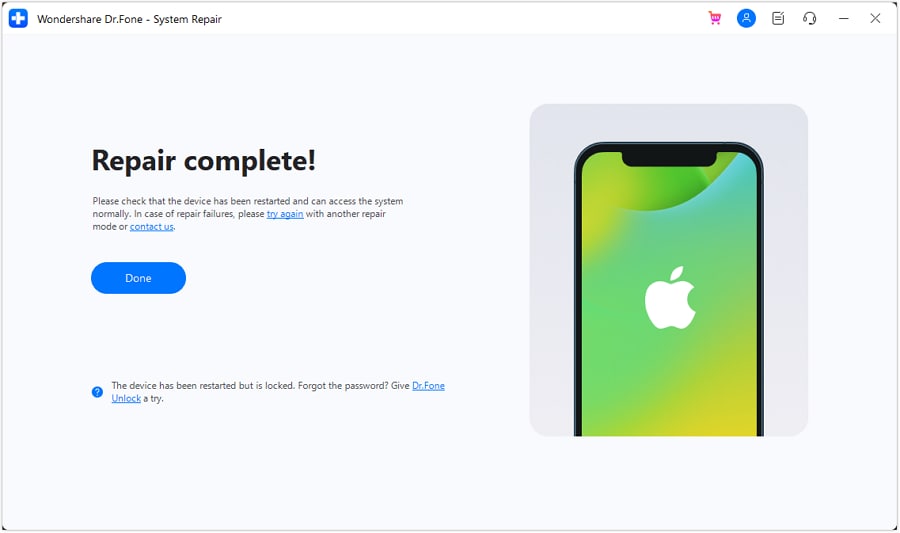Do These Things Before Using DFU Mode on iPhone X Series
Aug 27, 2025 • Filed to: Phone Repair Solutions • Proven solutions
Fixing most iPhone issues can be solved with a relatively simple action of restarting your device. But sometimes, this isn't the case, and you need to either go into Recovery Mode or DFU mode. DFU, or Device Firmware Update, differs from Recovery Mode because it allows devices to be restored from any state.
Recovery Mode utilizes iBoot for upgrading or restoring your iPhone. On the other hand, DFU Mode is embedded in your iPhone and allows upgrading and downgrading as there's no iBoot agent. Now that you know the basics, we'll teach you how to navigate iPhone X DFU mode. We'll also teach you iPhone XR DFU Mode, iPhone XS DFU Mode, and XS Max to cover all X Series. Follow the guide below to learn how.

- Part 1. What is DFU Mode Used For?
- Part 2. Things to Note Before Opening DFU Mode on iPhone X, XS, XS Max, and XR
- Part 3. How to Enable DFU Mode On iPhone X, XS, XS Max, and XR?
- Part 4. How to Exit DFU Mode on iPhone X, XS, XS Max, and XR? [Normally]
- Part 5. How to Fix iPhone X Stuck in DFU Mode Without Losing Data?
Part 1. What is DFU Mode Used For?
For iOS issues, Recovery Mode almost always solves any problem on your iPhone. However, if your iOS is corrupted and Recovery Mode can't fix it, DFU Mode is necessary under specific circumstances.

Here are some instances when you have to use DFU mode:
- Fix an iPhone that won't reboot past the Apple logo during start-up.
- Jailbreak or un-jailbreak an iOS device.
- Remove an expired iOS beta version.
- Downgrading to a previous iOS version if an updated iOS compromised your device or caused some apps to malfunction.
Part 2. Things to Note Before Opening DFU Mode on iPhone X, XS, XS Max, and XR
Here are some tips before using DFU Mode on iPhone X Series.
- DFU Mode will erase all data on your iPhone. Make sure to create a backup before going ahead with DFU Mode.
- Factors that include falls, impact, or water damage can compromise your iPhone. Hence, DFU Mode is not recommended for iPhones that suffered internal component damage.
Here's a nifty table comparing how to make backups using iCloud, iTunes, and a great alternative with Dr.Fone - Phone Backup.
| Features | iCloud Backup | iTunes Backup | Dr.Fone - Phone Backup |
| Mode of Backup | Requires persistent internet connectivity to access Cloud services | Requires a USB cable to connect the device to a computer | Requires software installation as well as a USB cable to connect the device to the program and computer |
| Data Backup Customization | Features a wide variety of options to allow you to customize your backup | Does not offer selective backup options. | Features comprehensive options to choose from when backing up data |
| Restore Options | Restores during initial setup | Restores during initial setup or after setting it up for some time | Restores during initial setup or after setting it up at any time |
| How Much Data Can Be Backed Up? | With 5GB free cloud storage, which can increase to 2TB via subscription plans | Depends on the storage space of the computer | Depends on the storage space of the computer |
| How is It Processed? | Through Settings on the iPhone | Through iTunes on your computer and accessing Backup | Through Dr.Fone's program and accessing System Repair |
Part 3. How to Enable DFU Mode On iPhone X, XS, XS Max, and XR?
After reading how DFU mode works, it's time to tackle how to enable it. Take note that has removed the Home button for the iPhone X series. It means that the process to enter DFU mode has totally changed. Here's how to enable DFU mode on iPhone XR, X, XS, and XS Max.
Step 1: Use a USB cable and connect your iPhone to a computer. Afterward, launch iTunes.

Step 2: Grab your iPhone and do the following while it's still connected to the computer. Press and release Volume Up. Next, press and release Volume Down. Third, press and hold the Side button. Wait for the iPhone screen to go black. Continue holding the Side button and pressing and holding Volume Down now. Wait between 5-8 seconds before releasing the Side button. Keep holding Volume Down until iTunes recognizes your iPhone.

Step 3: Once iTunes detects your iPhone, release your hold on Volume Down. Wait for a pop-up on iTunes. It indicates that your iPhone X, XR, XS, or XS Max, has successfully entered DFU mode.

Tips
- DFU Mode is not the same as Recovery mode, which people are often confused with. Under DFU Mode, your iPhone's screen will stay black and not show an Apple logo, unlike Recovery Mode.
- If the Apple logo appears while doing the steps, you've held the Side button too long. You'll have to redo the steps from the start.

Part 4. How to Exit DFU Mode on iPhone X, XS, XS Max, and XR? [Normally]
Your iPhone will automatically reboot and exit DFU mode if your restoration is done right. If you've entered DFU mode by mistake, here's how to go to DFU mode. Follow the guide below.
Step 1: In quick succession, press and quickly release Volume Up. Do the same for Volume Down.
Step 2: Press and hold the Side button. Wait until the Apple logo appears on the screen.

Part 5. How to Fix iPhone X Stuck in DFU Mode Without Losing Data?
Sometimes, your iPhone's DFU Mode isn't enough to fix your iOS issues. If this happens to you, use a dedicated program like Dr.Fone - System Repair (iOS), as it usually gets the job done.
Key Features
Dr.Fone - System Repair (iOS) has many features you can immediately take advantage of. Here are some of the key elements of the program.
- Dr.Fone is extremely beginner-friendly. It's a pretty simple process and will take a couple of clicks.
- It supports upgrading or downgrading iOS.
- Dr.Fone works across all iOS versions, including iOS 16.
Here are the steps to repair your iPhone using Dr.Fone - System Repair (iOS) if it's stuck in DFU mode without losing data.
Step 1: Download and install Dr.Fone - System Repair (iOS). Launch the program and connect your iPhone to your computer with a USB cable.

Step 2: Click System Repair. Choose and download the correct firmware for your iPhone on the provided list.

Step 3: Recovering your iPhone stuck in DFU mode lasts 10-15 minutes. Wait for the Standard Repair process to finish without touching your iPhone. Wait for the image, as seen below, to appear. It means the repair process has been completed.

Note:
Your device will automatically update to the latest iOS version to fix your iPhone stuck in DFU mode.
Conclusion
Entering DFU Mode is necessary under specific circumstances. You'll usually have to do it if Recovery Mode does not solve your problem. However, if both methods fail, don't worry, as you still have an alternative. Dr.Fone can fix your iPhone even if you've accidentally bricked it while entering DFU mode. Knowing you have several options is essential, so you will not panic when your iPhone is experiencing issues.
iPhone Reset
- iPhone Recovery Mode
- 1. Exit iPhone Recovery Mode Loop
- 2. iPhone in Recovery Mode
- 3. iPhone Recovery Mode
- 5. Get Data from iPhone in Recover Mode
- 6. Put iPhone in Recovery Mode
- 7. Recuva Data Recovery Review
- 8. DFU Mode vs Recovery Mode
- iPhone DFU Mode
- 1. Put iPhone in DFU Mode
- 2. Enter and Exit DFU Mode
- 3. Get Data from iPhone in DFU Mode
- 4. Tools for iPhone to Enter DFU mode
- 5. Enter/Exit DFU Mode on iPhone X
- 6. Enter/Exit DFU Mode on iPhone SE
- 7. DFU Mode Works on iPhones
- 8. Enter DFU Mode on iPod Touch
- iPhone Factory Reset
- 1. Factory Reset iPhone
- 2. Factory Reset iPhone without iTunes
- 3. Reset iPhone without Passcode
- 4. Reset iPhone Without Apple ID
- iPhone Hard Reset
- 1. Hard Reset VS Soft Reset iPhone
- 2. Hard Reset Without Computer
- 3. Force Restart iPhone
- 4. Restart or Force Restart iPhone
- 5. Hard/Soft/Factory Reset iPhone 8
- iPhone Reset Tips
- 1. Soft Reset iPhone
- 2. Restart or Reboot iPhone
- 3. iPhone Reset All Settings
- 4. Reset iPhone Battery
- 5. Reset iPhone without Apple ID
- 6. Reset Jaibroken iPhone
- 7. Reset Network Settings On iPhone
- 8. Reset Restriction Passcode iPhone
- 9. Restart iPhone Without Power Button
- 10. Turn Off iPhone Without Home Button
- 9. Turn off iPhone without Screen
- 10. Reset Disabled iPhone

















James Davis
staff Editor
Generally rated4.5(105participated)